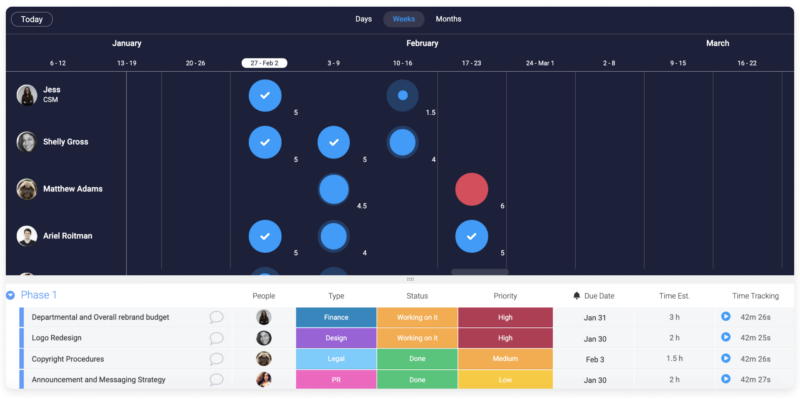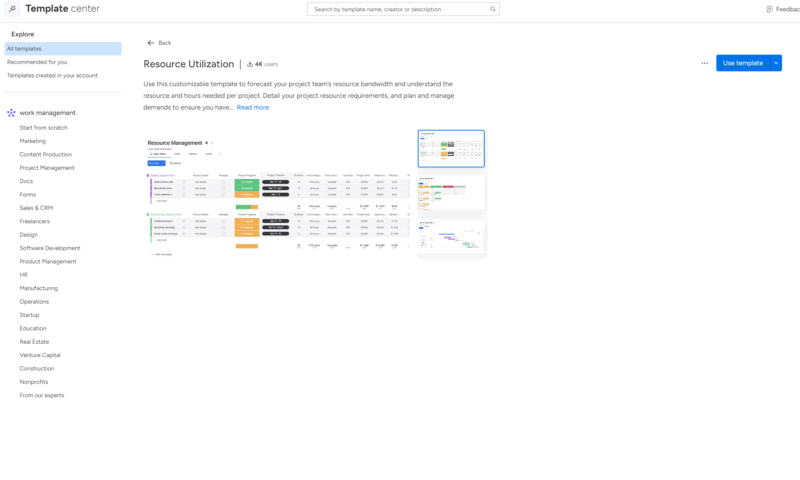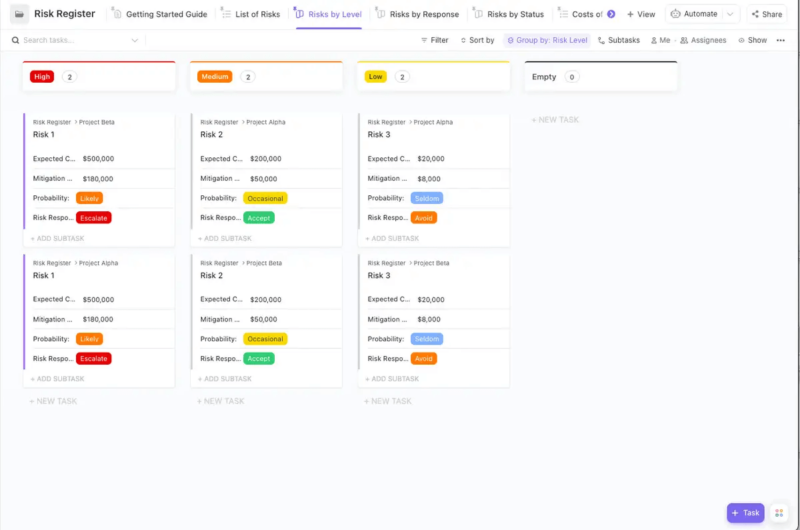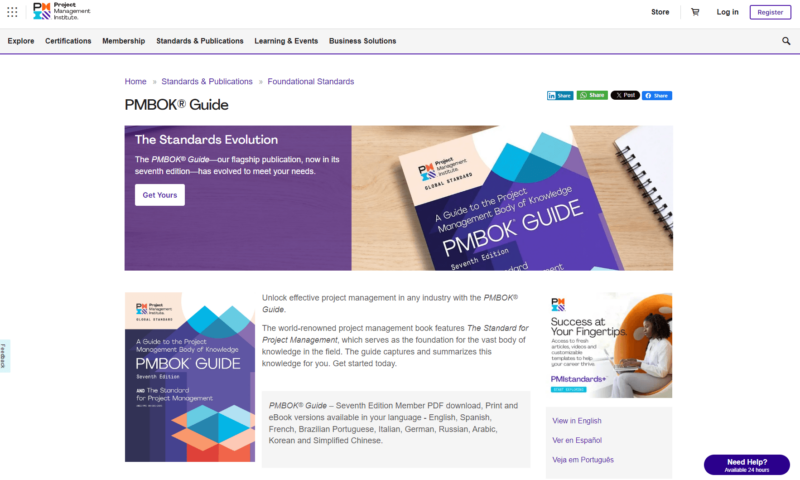Even with the best project management software and a solid project quality plan, projects don’t always go the way you want. You may miss deadlines or run out of resources. In this case, a project manager may look at resource leveling vs resource smoothing and decide which project management technique is best to use to get the project back on track.
If you’re unfamiliar with resource leveling and resource smoothing, don’t worry; we’ll explain what they mean. We’ll also cover when to use each technique and which is best to ensure you remain as close to your initial project schedule as possible. We’ll also explain the advantages and disadvantages of each approach. Let’s get started.
Resource Leveling vs Smoothing in Project Management: Definitions
We’ll begin by clearly defining both resource leveling and resource smoothing. This will give you a better understanding of what they are and when they can best be implemented during a project.

Resource Leveling vs Resource Smoothing: Differences
Resource leveling allows you to change your project’s start and end dates when you have limited resources. On the other hand, resource smoothing involves adjusting your resource requirements in order to meet the initial deadline.
While resource leveling, a project manager can tweak the project’s critical path, extending the time it takes to finish the essential tasks to complete the project. Though this technique extends the project duration, it helps ensure your team can complete the work to the highest standard and finish the project’s deliverable.
With smoothing, a project manager doesn’t have the luxury of being able to adjust the critical path to delay the project’s delivery. To counter this, they must assess how best to use their critical resources.
In these moments, project managers use their experience in resource planning and management to ensure they can allocate resources effectively. You can learn more about resource planning in our capacity planning vs resource planning guide. Our handy table below lists a few of the key differences between resource leveling and smoothing.
| Resource Leveling | Resource Smoothing |
|---|---|
| Project managers can adjust the start and end date of a project. | Your project start and end date cannot change. |
| You extend your critical path to accommodate for limited resources. | Managers readjust resource allocations when they’re uneven. |
| Resource leveling can be implemented when you have too many or too few available resources. | The critical path cannot be altered when implementing resource smoothing. |
Are There Any Similarities Between Resource Leveling & Smoothing?
In essence, resource leveling and resource smoothing fall under the resource management tree. Though the outcomes differ, there are some similarities in how you approach each technique. You will need to be analytical in both approaches, identifying what you need to change in order to deliver the best work possible.
You will also need to tap into your analytical skills in order to decide which technique you should use. Effective communication skills are also necessary, as you’ll use them when discussing whether you can adjust your deadlines.
When to Use Resource Leveling
Below, we share some pointers to help you determine when to use resource leveling. We also include some examples and go over some of the advantages and challenges of using this technique.
- When workload outweighs workforce: If the project tasks require many hours to complete, but your workforce is limited, you can use leveling to adjust your critical path. This ensures nobody is overworked.
- When overloaded with tasks: If you have too many different task deadlines within a specific time frame, you can adjust due dates and give yourself more time to focus on each respective task. To learn more about this, check out our guide to Critical Chain Project Management.
- When quality is reduced: Task and project deadlines can put pressure on your team. This can sometimes lead to rushed work and low-quality output. To ensure quality remains consistent, you can implement resource leveling so your team can spend more time completing tasks.
Use Case Example
Resource leveling doesn’t pertain only to workload issues. It can also relate to issues with physical resources such as product materials. For example, imagine your company has a client that needs you to build a physical product, and they demand more units during the project. To accommodate this change, you may need to bring in more materials.
Bringing in more materials will require you to adapt the critical path and change your deadline in order to meet your client’s new demands. Still, it will enable you to deliver a high-quality end result.
Resource Leveling Advantages
There are several advantages to using resource leveling. We highlight some of them below.
Reduces Pressure
Due to the flexibility resource leveling brings, the amount of pressure put on your team and available resources decreases. A reduction in pressure can lead to a reduction in stress, which can help you focus clearly.
Keeps Costs Low
Resource leveling is good for anyone who doesn’t want to go too far over budget. Because you’re adjusting time frames and not adding more resources, you don’t need to worry about investing more capital. We recommend using leveling as a primary solution if your company has a tight budget or low initial capital for the project.
Improves Productivity
The resource leveling technique can improve productivity by giving people more time to focus on tasks. This way, they’re not overwhelmed by an unrealistic workload. Instead, they can focus on critical tasks over a longer time period.
Resource Leveling Challenges
For all the benefits it brings, resource leveling also has challenges. Let’s take a look at some of the most common obstacles that appear when using this technique.
It Can Be Displeasing for Stakeholders
Project managers want to complete a project by the initial deadline; however, there are times when this might not be possible. Using leveling to adjust project end dates is okay, but it can lead to frustration if it’s continuous. This could anger clients and internal and external stakeholders, thus leading to more pressure on you.
Can Risk Further Resource Constraints
Even after making adjustments, resource constraints can still continue to develop. This means making more adjustments, which can further slow down the completion of your project. To learn more about constraints, check out our guide to the theory of constraints.
When to Use Resource Smoothing
Moving forward, let’s look at some examples of when you can use resource smoothing.
- When time constraints are a priority: If you have no flexibility to change your task and project deadlines, it’s time to turn to the resource smoothing technique.
- When deadlines are moved forward: Clients may sometimes ask you to reduce the project timeline. Your project plan may have resource allocations for six months, but now you need to fit them into three. This will no doubt cause resource conflicts. You can use smoothing to make adjustments and meet the new deadline.
Use Case Example
Imagine your project involves launching a new product. Your client initially said the launch date would be in nine months, and you created a plan to allocate resources for materials, production and delivery of the product.
Due to a competitor releasing a product at a similar time, your client asks you to bring the product launch forward. In order to do so, you can use resource smoothing to add additional resources without fast-tracking tasks so much that it leads to a drop in quality.
Resource Smoothing Advantages
Below, we examine the core advantages of resource smoothing so you better understand how this technique can help you.
It Doesn’t Impact Your Critical Path
When using the smoothing technique, the most important tasks within your critical path don’t change. This helps keep focus high and team morale strong. None of the milestones, dependencies and tasks you set will change; only your resource allocation will.
Helps Meet Deadlines
The purpose of smoothing is to ensure you meet your primary goal on time. This is especially important if you’re delivering a product to your customer base, as orders are coming in and avoiding delays is essential.
Resource Smoothing Challenges
As with leveling, some challenges can arise while using the smoothing technique. We cover them below.
Can Lead to Overspending
When your resources are stretched and time is limited, you may need to use extra capital to add more resources. Naturally, this means your spending will likely exceed your initial expectations. Overspending can hurt your bottom line and lead to scope creep.
It’s a Complex Process
Resource smoothing isn’t just about throwing more resources at the wall and seeing what sticks. It takes time and plenty of analytical skills to decide which resources you need to add and when best to add them. Remember, the goal is to meet your deadline, and if you misjudge resource smoothing it can lead to further delays or an oversaturation of resources.
Which Is Best? Resource Smoothing vs Resource Leveling
Between resource smoothing and resource leveling, there’s no definitive best technique to use. The real answer is finding the best option for your situation. If there are fewer time constraints, go with leveling. If deadlines are strict, then smoothing will be your best approach.
Tips for Using Resource Leveling and/or Smoothing
Below, we share some tips for leveling and smoothing. Think of them as best practices that can help you get the most out of each technique.
Use Project Management Tools

Many of the best free project management software platforms have tools and templates that can help you manage your project resources. monday.com is our top choice, as it’s easy to use and great for teams of all sizes. Our monday.com review explains why we like it so much.
Practice Risk Assessment

A risk assessment helps you identify potential areas where a project may change course. By knowing the risks, you can come up with a plan of action before they occur. This facilitates the process of making resource adjustments. If you’re looking for software that can help you create risk assessment plans, check out our ClickUp review.
Final Thoughts
That brings our project management technique comparison to a close. It should be clear by now that resource leveling and smoothing can prevent your project from failing and help keep it on track. Remember, the process that will benefit you the most depends heavily on your situation.
Leveling will serve you well if you have the luxury of time and are able to readjust how you use your resources. Smoothing will be a lifesaver in situations where flexibility isn’t an option and you need to complete your project on time and to the expected standard. Do your due diligence before committing, and we’re confident you’ll make the right choice.
Did you find this guide helpful? Which technique is your favorite? What other project management processes would you like us to explore? Let us know in the comments. Thanks for reading.
FAQ: Resource Leveling vs Resource Smoothing
-
Resource leveling allows you to adjust your project deadline, while resource smoothing helps you make the most of your available resources, ensuring there are no project delays.
-
Resource leveling involves adjusting project duration and deadlines, whereas crashing allows you to add additional resources so you can complete tasks and reach deadlines.
-
Resource leveling entails reacting to having too little or too many resources by adjusting your critical path and extending your project’s end date.
{“@context”:”https:\/\/schema.org”,”@type”:”FAQPage”,”mainEntity”:[{“@type”:”Question”,”name”:”What Is the Difference Between Resource Leveling and Resource Smoothing?”,”acceptedAnswer”:{“@type”:”Answer”,”text”:”
Resource leveling allows you to adjust your project deadline, while resource smoothing helps you make the most of your available resources, ensuring there are no project delays.\n”}},{“@type”:”Question”,”name”:”What’s the Difference Between Resource Leveling and Crashing? “,”acceptedAnswer”:{“@type”:”Answer”,”text”:”
Resource leveling involves adjusting project duration and deadlines, whereas crashing allows you to add additional resources so you can complete tasks and reach deadlines.\n”}},{“@type”:”Question”,”name”:”What Is Resource Leveling in Project Management? “,”acceptedAnswer”:{“@type”:”Answer”,”text”:”
Resource leveling entails reacting to having too little or too many resources by adjusting your critical path and extending your project\u2019s end date.\n”}}]}
The post Resource Leveling vs Resource Smoothing: Definitions, Differences, Pros & Cons Explained in 2024 appeared first on Cloudwards.


